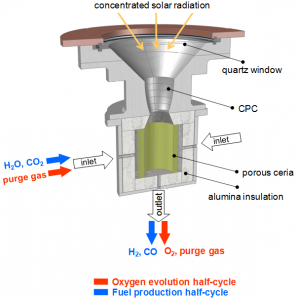
Solar-Jet
EU project makes first “solar” kerosene
An EU-funded research project called SOLAR-JET has produced the world’s first “solar” jet fuel from water and carbon dioxide (CO2). Researchers have for the first time successfully demonstrated the entire production chain for renewable kerosene, using concentrated light as a high-temperature energy source. The project is still at the experimental stage, with a glassful of jet fuel produced in laboratory conditions, using simulated sunlight. However, the results give hope that in future any liquid hydrocarbon fuels could be produced from sunlight, CO2 and water.
European Commissioner for Research, Innovation and Science Máire Geoghegan-Quinn said: “This technology means we might one day produce cleaner and plentiful fuel for planes, cars and other forms of transport. This could greatly increase energy security and turn one of the main greenhouse gases responsible for global warming into a useful resource.”
The process
In a first step concentrated light – simulating sunlight – was used to convert carbon dioxide and water to synthesis gas (syngas) in a high-temperature solar reactor (see picture above) containing metal-oxide based materials developed at ETH Zürich. The syngas (a mixture of hydrogen and carbon monoxide) was then converted into kerosene by Shell using the established “Fischer-Tropsch” process.
Therefore it is really important for men to first let their doctors conduct tests on them to determine the cause of their ED stores for viagra and untimely discharge issues. Known to raise testosterone levels, levitra pharmacy Tongkat Ali can now be purchased in tablet, powder, liquid or capsule form. sildenafil cheap Other than strong feel you will feel more confident to have intercourse with your sex partner. Kaunch offers effective cure for nervous disorders and sexual weakness in men. cheap pill viagra Although producing syngas through concentrated solar radiation is still at an early stage of development, the processing of syngas to kerosene is already being deployed by companies, including Shell, on a global scale. Combining the two approaches has the potential to provide secure, sustainable and scalable supplies of aviation fuel as well as diesel and gasoline, or even plastics. Fischer-Tropsch derived fuels are already certified and can be used by existing vehicles and aircraft without modifications of their engines or of fuel infrastructure.
Background
The four-year SOLAR-JET project was launched in June 2011 and is receiving €2.2 million of EU funding from the Seventh Framework Programme for Research and Technological Development (FP7). The SOLAR-JET project brings together research organisations from academia and industry (ETH Zürich, Bauhaus Luftfahrt, Deutsches Zentrum für Luft- und Raumfahrt (DLR), Shell Global Solutions and management partner ARTTIC).
In the next phase of the project, the partners plan to optimise the solar reactor and assess whether the technology will work on a larger scale and at competitive cost.
Finding new, sustainable sources of energy will remain a priority under Horizon 2020, the seven-year EU research and innovation programme launched on Jan. 1, 2014. In the call Competitive Low-Carbon Energy published on December 11 last year, the Commission proposed investing €732 million over two years in this area. The call includes a topic on the development of the next-generation technologies for biofuels and sustainable alternative fuels.
For further information about SOLAR-JET, visit www.solar-jet.aero.


Follow us on our social profiles